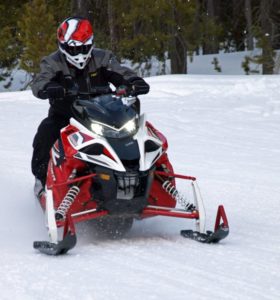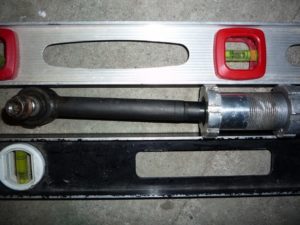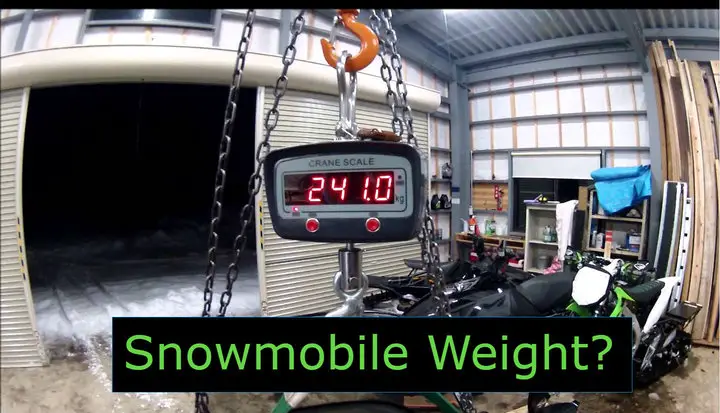Maybe you are just curious or you want to know how much do snowmobiles weight for a good reason. This article will present you how much does a snowmobile weight and will help you to solve related problems.
My snowmobile “weight” problem appeared when I bought a new snowmobile and I wanted to know if my trailer is good to go or I need to buy a new one. Obviously, the car will be able to tow it as it’s not a very heavy thing. Let’s go ahead and give you a short answer to this question and then I will move on to other details.
So, how much do snowmobiles weigh?
I did some research and I took the 10 most popular snowmobiles on market this year. I added the weights, did the average and found out that a typical snowmobile weight about 476 pounds or 215 kg. Ranging from 408 (185 kg) pounds to 600 (272 kg) pounds depending on the class, engine, accessories, how many seats and so on.
Note: I only computed the data from their specification based on the DRY WEIGHT. This means that considered snowmobiles don’t have any additional gas, gear, accessories, equipment or snow on them. Depending on the gear you put on and additional accessories you can expect an 11 lbs (5 kg) to 110 lbs (50 kg) additional weight.
Note that on average the fuel tank is 7-12 gallons and that is about 58 – 100 lbs (26 – 45 kg) of added weight. Also, don’t forget about the oil. The oil in a typical snowmobile is adding about 7 lb of weight on average or 3.2 kg. So the weight added with additional accessories and gear can add up pretty fast.
You can find out the real value for your snowmobile reading the specs on the manufacturer’s website or checking your owner’s manual.
Here are the most popular up-to-date snowmobiles and their weight so you can get a clear idea. Notice again that the values are of dry weight and most of them are estimates from the seller. Sometimes it may depend on the gear, accessories etc. but it serves as a good example.
Usually, the real dry weight is -+5% of the specified weight. If you want to put it on your trailer always calculate the total weight estimating the accessories, gear, gas and add 10% to that estimation. This way you can get a value that is pretty close to reality.
Examples:
1. SKI-DOO MXZ X 850 E-TEC
475 lb (215 kg ) – Dry Weight, No fuel, No gear, No oil
2. Rush 600 RUSH® PRO-S
432 lb (196 kg)– Dry Weight, No fuel, No gear, No oil
3. YAMAHA SIDEWINDER L-TX LE
No weight on the manufacturer website. The third most popular snowmobile, but I couldn’t find the dry weight. I’ve put it here only for reference, sorry for that.
4. SKI-DOO FREERIDE 850 E-TEC 165
Varies from / 454 lb (154 in.) (206 kg ) to 461 lb (165 in.) (209 kg) – Dry Weight, No fuel, No gear, No oil
5. SKI-DOO RENEGADE BACKCOUNTRY 850 E-TEC
478 lb (217kg) – Dry Weight, No fuel, No gear, No oil
6. POLARIS 600 INDY
449 lb / (204 kg) – Dry Weight, No fuel, No gear, No oil
7. Arctic Cat ZR 8000 ES 129/137
503 lb (228 kg) – Dry Weight, No fuel, No gear, No oil
8. POLARIS 800 PRO-RMK 155
408 lb (185 kg) – Dry Weight, No fuel, No gear, No oil
9. YAMAHA APEX LE
600 lbs (273 kg) – Dry Weight, No fuel, No gear, No oil
10. SKI-DOO MXZ TNT 900 ACE
490 lb (222 kg) – Dry Weight, No fuel, No gear, No oil
What influences the weight of snowmobile?
Engine
The main component that influences the weight is certainly the engine size. The average snowmobile engine weights  about 86-160 lb (40 – 73 kg). For example, a Yamaha Nitro Engine weights about 120 lb (approximately 55 kg) without the turbo. Another example is the Ski Doo 800R engine which weights 86 lb (39 kg) in a box. A 900 carbed engine weights about 90 lb (41 kg).
about 86-160 lb (40 – 73 kg). For example, a Yamaha Nitro Engine weights about 120 lb (approximately 55 kg) without the turbo. Another example is the Ski Doo 800R engine which weights 86 lb (39 kg) in a box. A 900 carbed engine weights about 90 lb (41 kg).
Skis
The skis weight depend on the material of which they are made. There are 2 main types of materials used for producing the skis: metal and plastic. The metal skis weight a bit more than the plastic equivalent (usually, 20-30%).
Metal ski weighed about 12.5 lbs (according to my bathroom scale) and the plastic weighed about 7.5 (same scale)
Snowmobile tracks weight
Snowmobile tracks weight is around 34 lb or (15.5 kg). It depends on the type, length, and width but some of the usual ones are:
- 51 pounds (23 kg)
- 14.7 pounds (6.6 kg)
- 37 pounds (17 kg)
Other small things that can influence the weight of your snowmobile are chaincase oil, engine coolant, shock, and brake fluid capacities. These depend on the model of the snowmobile and the engine.
How to determine the tow/trailer allowed weight?
Usually, the tow/trailer will have a sticker somewhere with a VIN number. That number is a unique identification of the chassis component. The VIN (Vehicle Identification Number) number is formed out of 17 characters. If it’s less than that it can mean it’s an old trailer (1980 or before)
Using that number you can find online, in the owner’s manual or at your dealership, the maximum allowed weight that you can tow.
On most trailers, the weight rating will be specified somewhere on the same sticker as the VIN number.
You shouldn’t worry too much though, the average trailer can support 1650 lb (750 kg). Weighing only 408 (185 kg) pounds to 600 (272 kg) pounds a normal snowmobile even with a full tank, oil, gear, and accessories will be ok to tow. Even sport trail snowmobiles or utility ones can fit in that range. Make sure you check the dimensions also!
How Construction Type Affects Weight
As you may know or guess there are many types of snowmobiles. The types I have heard of are:
- Trail snowmobile – I guess many of us own this type of snowmobile, this is usually the entry-level snowmobile. Usually, a shorter and lighter snowmobile that is easy to ride. They have around 60-70 horsepower which is enough for one beginner.
- Sport trail snowmobile – In general they have big engines so they are heavier due to this fact
- Touring snowmobile – This type is designed for two persons so it has one extra seat in the back – Usually, they have a slightly bigger engine because 2 persons are heavier than one, right?
- Performance snowmobile – Again, big engine, heavy. Usually, engines are 85 horsepower or even bigger. As the name says, they are performance oriented so there is also an extra weight given by the suspension systems, shock absorbers, and other parts
- Utility snowmobile – This one is used to carry stuff and trailers. So again they are longer and heavier than usual snowmobiles. This type of snowmobile is often used by hotels/resorts for carrying the visitor’s luggage or for work-related stuff.
- Crossover snowmobile – Usually they have a longer track and can be used in deep, fresh snow. So if you are an explorer of the woods you can take a look at this type. Extra suspension adds extra weight but improves maneuverability and ride.
- Mountain snowmobile – As the name suggests they are used for climbing the mountains. They can be used in deep powder as they are specially designed for that. They also have a bigger engine which makes them heavier than the usual trail snowmobile. Mountains ain’t easy so the extra power is needed for that. They also have long lug tracks which makes them perfect for deep snow.
Understanding the Listed Numbers
Sometimes is confusing because different manufacturers show different values on the specifications. So it is a bit confusing to understand all these terms. As you noticed, I took the dry weight of the snowmobiles for the above list. This is because different snowmobiles have different fuel tank sizes, oil capacity and may require different extra gear.
Here is a little explanation to understand better what these numbers mean:
DRY WEIGHT – Refers to the weight of the snowmobile without any fuel, oil, gear, brake fluid, coolant, power steering fluid, transmission fluid, washer fluid etc.
GROSS WEIGHT – This value represents the weight of the snowmobile including a full fuel tank, oil, brake fluid, coolant, power steering fluid, transmission fluid, washer fluid etc. and the average extra gear. This usually represents the maximum amount that the snowmobile could weigh.
How to take the weight off front skis
When there is too much pressure or weight on the front skis you may feel you are losing the grip on the snow. If the snowmobile is darting or you may want a bit of lift you may ask this question: How to take off the weight on the front skis.
Usually, the adjustment of shock absorbers doesn’t work with this and there are few good solutions to this problem that don’t involve buying a brand new lighter snowmobile. The best shot you have is increasing the front skid spring preload. As this is the balance point of suspension you may take some weight out of the front part.

It’s important to always keep the transfer rods in the center. Check this after you do the spring preload changes. If the transfer rods is not centered the snowmobile driving can become a pretty difficult task.
These are the options you have, but remember to do one adjustment at a time and test to see if the ride is any better. Otherwise, you won’t know what works and what doesn’t and you may even ruin your suspension.
- Loosen limiter straps
 Increase front track shock spring preload
Increase front track shock spring preload- Decrease rear track shock preload
- Decrease front ride height or preload
How to carry your snowmobile on a trailer/tow?
This doesn’t work pretty good for flexible skis and for some may not work at all as it’s putting too much pressure on the ski but here is: Take a short rope and tie the ski tip to the bumper of the towing sled. Using this method the sleds are locked to each other so there is no need for steering or for braking.
If you have a tow strap you can tie it to the ski spindles as the bumper is very fragile on some snowmobiles and it’s a possibility that it can’t support the force. You could pull it off if the bumper is very weak or poor quality.
Do You Need a Truck?
Most cars, vans or trucks can tow 7700 lb (3.500kg) but that includes the car itself. The combined weight of the car and trailer should not be over 7700 lb (3.500 kg). It depends on legislation, but with a snowmobile or two, you should be good.
Here is an interesting video with the guys from Arctic Cat weighting three types of snowmobiles.
They compared the 2013 Mountain 800s the Artic Cat, Ski Doo 800 SP 154 and Polaris 800 PRO RMK 155.
They made a pretty good job assuring this is a fair test, weighting each snowmobile dry but with full tank (which can be different on each snowmobile). Also, they added an extra belt and toolkit on each one.
They wanted a real test so they drive it a little bit to allow on the snowmobile. After some downhill powder turns they weighed them and compared to the dry weight.
Curious about how much did the collected snow weight? The results were a bit different from snowmobile to snowmobile, that’s because of their design. So the weight added by snow was 47 lb (Arctic Cat), 83 lb (Ski Doo Snowmobile) and respectively 94 lb (Polaris Snowmobile).
Conclusion
I really hope you found an answer and now you know how much does a snowmobile weight and why. Also, you know what influences the weight and solutions to different questions you may have had. If I missed something important or just something that you want to know feel free to write a comment in the section below and I will try to answer it as soon as possible. Have fun riding your snowmobile and be safe!
